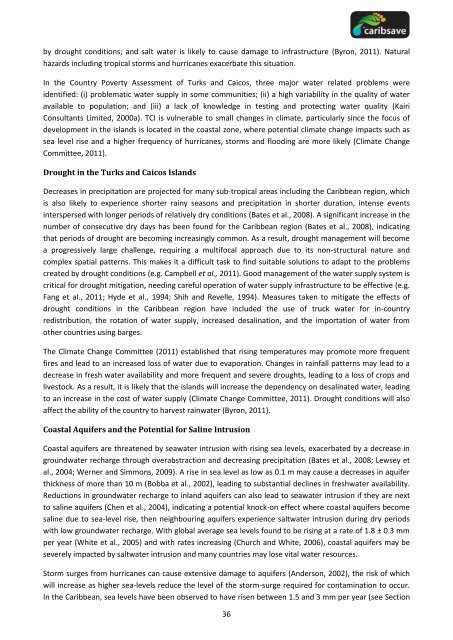Create successful ePaper yourself
Turn your PDF publications into a flip-book with our unique Google optimized e-Paper software.
y drought conditions; <strong>and</strong> salt water is likely to cause damage to infrastructure (Byron, 2011). Natural<br />
hazards including tropical storms <strong>and</strong> hurricanes exacerbate this situation.<br />
In the Country Poverty Assessment of <strong>Turks</strong> <strong>and</strong> <strong>Caicos</strong>, three major water related problems were<br />
identified: (i) problematic water supply in some communities; (ii) a high variability in the quality of water<br />
available to population; <strong>and</strong> (iii) a lack of knowledge in testing <strong>and</strong> protecting water quality (Kairi<br />
Consultants Limited, 2000a). TCI is vulnerable to small changes in climate, particularly since the focus of<br />
development in the isl<strong>and</strong>s is located in the coastal zone, where potential climate change impacts such as<br />
sea level rise <strong>and</strong> a higher frequency of hurricanes, storms <strong>and</strong> flooding are more likely (Climate Change<br />
Committee, 2011).<br />
Drought in the <strong>Turks</strong> <strong>and</strong> <strong>Caicos</strong> Isl<strong>and</strong>s<br />
Decreases in precipitation are projected for many sub-tropical areas including the Caribbean region, which<br />
is also likely to experience shorter rainy seasons <strong>and</strong> precipitation in shorter duration, intense events<br />
interspersed with longer periods of relatively dry conditions (Bates et al., 2008). A significant increase in the<br />
number of consecutive dry days has been found for the Caribbean region (Bates et al., 2008), indicating<br />
that periods of drought are becoming increasingly common. As a result, drought management will become<br />
a progressively large challenge, requiring a multifocal approach due to its non-structural nature <strong>and</strong><br />
complex spatial patterns. This makes it a difficult task to find suitable solutions to adapt to the problems<br />
created by drought conditions (e.g. Campbell et al., 2011). Good management of the water supply system is<br />
critical for drought mitigation, needing careful operation of water supply infrastructure to be effective (e.g.<br />
Fang et al., 2011; Hyde et al., 1994; Shih <strong>and</strong> Revelle, 1994). Measures taken to mitigate the effects of<br />
drought conditions in the Caribbean region have included the use of truck water for in-country<br />
redistribution, the rotation of water supply, increased desalination, <strong>and</strong> the importation of water from<br />
other countries using barges.<br />
The Climate Change Committee (2011) established that rising temperatures may promote more frequent<br />
fires <strong>and</strong> lead to an increased loss of water due to evaporation. Changes in rainfall patterns may lead to a<br />
decrease in fresh water availability <strong>and</strong> more frequent <strong>and</strong> severe droughts, leading to a loss of crops <strong>and</strong><br />
livestock. As a result, it is likely that the isl<strong>and</strong>s will increase the dependency on desalinated water, leading<br />
to an increase in the cost of water supply (Climate Change Committee, 2011). Drought conditions will also<br />
affect the ability of the country to harvest rainwater (Byron, 2011).<br />
Coastal Aquifers <strong>and</strong> the Potential for Saline Intrusion<br />
Coastal aquifers are threatened by seawater intrusion with rising sea levels, exacerbated by a decrease in<br />
groundwater recharge through overabstraction <strong>and</strong> decreasing precipitation (Bates et al., 2008; Lewsey et<br />
al., 2004; Werner <strong>and</strong> Simmons, 2009). A rise in sea level as low as 0.1 m may cause a decreases in aquifer<br />
thickness of more than 10 m (Bobba et al., 2002), leading to substantial declines in freshwater availability.<br />
Reductions in groundwater recharge to inl<strong>and</strong> aquifers can also lead to seawater intrusion if they are next<br />
to saline aquifers (Chen et al., 2004), indicating a potential knock-on effect where coastal aquifers become<br />
saline due to sea-level rise, then neighbouring aquifers experience saltwater intrusion during dry periods<br />
with low groundwater recharge. With global average sea levels found to be rising at a rate of 1.8 ± 0.3 mm<br />
per year (White et al., 2005) <strong>and</strong> with rates increasing (Church <strong>and</strong> White, 2006), coastal aquifers may be<br />
severely impacted by saltwater intrusion <strong>and</strong> many countries may lose vital water resources.<br />
Storm surges from hurricanes can cause extensive damage to aquifers (Anderson, 2002), the risk of which<br />
will increase as higher sea-levels reduce the level of the storm-surge required for contamination to occur.<br />
In the Caribbean, sea levels have been observed to have risen between 1.5 <strong>and</strong> 3 mm per year (see Section<br />
36





